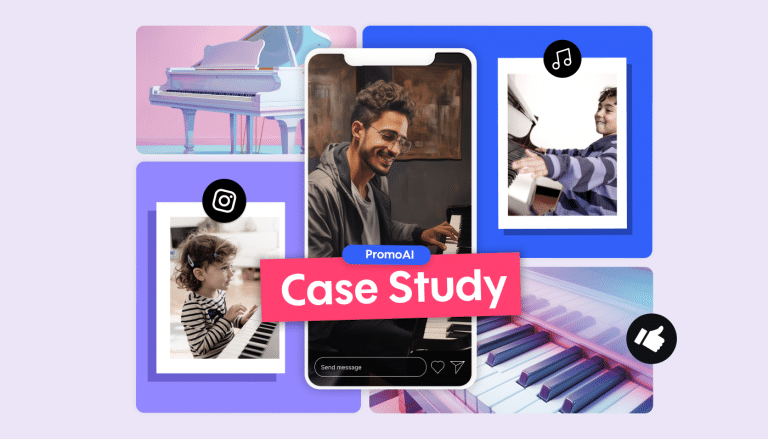
Marketing Storytelling: How to tell stories that sell
Storytelling.
It’s an art as old as humankind and continues to this day to be one of the most powerful communication tools. Skillful storytellers have shifted civilizations, formed religions, and brought to the uprising and downfall of humanity… so we can safely assume that it has the power to reach your audience and boost your business’s marketing efforts.
But before we learn how to use storytelling as a marketing tool, let’s understand exactly what it is and why it’s important.
What is storytelling?
Storytelling describes the cultural activity of sharing narratives, whether verbally, visually, theatrically, or through the written word.
Okay, but why is it so effective?
Good question. There is a three-part answer:
- A good story allows both the storyteller and the audience to sync and align with one another. When someone hears a compelling story their brain will actually anticipate what will be said next. It effectively achieves the ultimate goal of human communication – to convey information and emotions from one person to the next.
- A good story also has a lasting impact on the audience. It strings together data and events in an intuitive sequence that remains ingrained in the brain for a longer period of time.
- Stories not only remain in our conscious but in our subconscious as well. We think in the form of storytelling and it is the narratives that motivate our day-to-day behavior.
For instance, most people feel that it is safer to drive than to fly because we forget the stats but remember the traumatizing plane crash or disappearance stories that are often in the news. We are more prone to donate to children in a third-world country if we hear a single story with a name and face, than if we hear the stats of child poverty.
How to apply storytelling to your marketing
In the hope that that the section above convinced you of the power of storytelling, let’s move on to the question that’s on every marketer’s mind – How can we incorporate storytelling into our marketing efforts and use it to boost our business?
For the very reasons that we mentioned, storytelling has been identified by many CMOs as a key marketing imperative. It’s been found to be one of the best ways to engage customers and establish a brand.
But like we said in the very first line, storytelling is an art and needs to be honed. Not every pitch is considered a story and not every story is considered a good one. While it’s important to understand the significance of storytelling, it’s also important not to waste time and energy on pseudo-storytelling that won’t do anything to truly empower your brand.
Let’s discuss.
What makes a good marketing story?
If you paid any attention in English Lit 101, you’ll remember that every story must incorporate a number of essential elements. While key elements of a marketing story are slightly different, they are essential all the same.
3 key elements of storytelling marketing
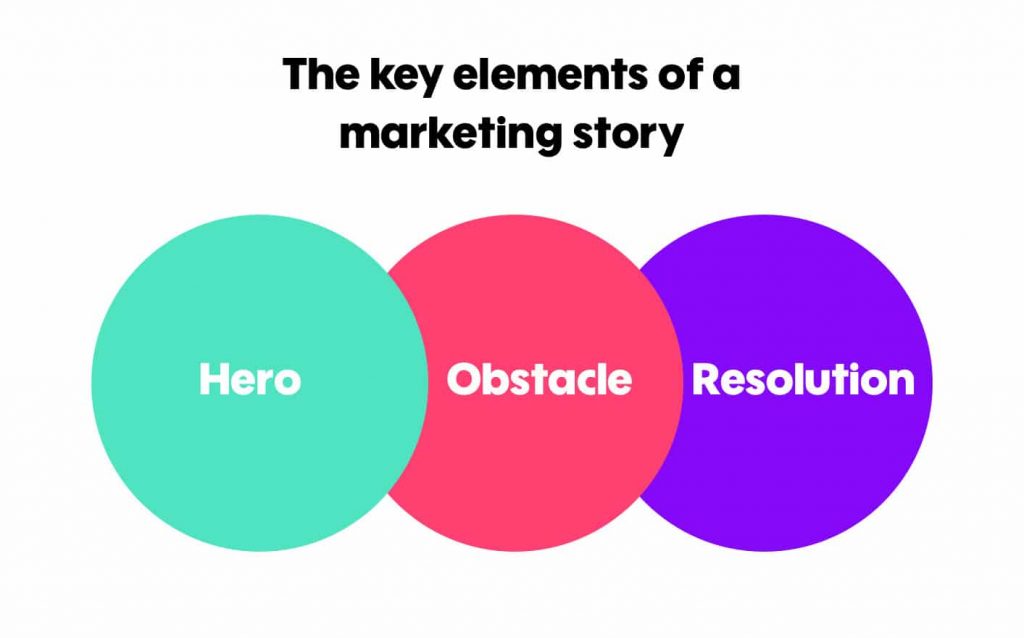
1.Hero
Your story needs someone relatable, but the most important thing to remember is that your business is never your main character. That is one of the biggest mistakes that businesses make when it comes to storytelling advertising. Telling a story that stars your business is unrelatable and easily ignorable.
To tell a good marketing story, your customer (or a relatable figure) should be the hero.
2.Obstacle
If there was no problem or complication, your customer wouldn’t need you. And more than that, your story would be pretty boring. The obstacle must be something that resonates with your audience and triggers a challenge that they face in their own lives.
Present an obstacle that your hero is not able to attain on their own without your business or product.
3. Resolution
Your business or product is the solution to the problem your hero faces. This doesn’t have to be as literal as it sounds but it should leave your audience with some sort of call-to-action. Wrap up your story with a feel-good resolution with your product at the forefront.
While your business is never the hero, it is almost always the solution to your hero’s problem.
These are the bare bones of every marketing story you tell and should serve as your road map as you move forward. Beyond these key elements, there are ample techniques that you can use to hone your craft along with a number of questions to ask (and answer) before you can craft a good story for your business.
Pre-storytelling preparation
Who is your target audience?
Just like with any other marketing strategy, you need to define your buyer persona before you can start. It is crucial to know who you are talking to before you decide what you are saying. Not every message, medium, and story will resonate with your audience, so figure out who it is you are targeting before you move ahead.
What is your goal?
Why are you even crafting a marketing story? You know now who it is you are marketing to, but what is your end goal? There are a few storytelling marketing goals:
- To drive action – In this instance, you want the story to directly push your user to take action.
- To raise brand awareness – This is where brand storytelling comes in. It is the attempt to use narrative to connect customers to your brand.
- To teach and educate – The goal here is to teach your audience something new that will ultimately bring them closer to your brand.
- Foster relationships – Here is where your story will share values and make your audience feel as if they have common ground with your brand.
What is your message?
At this point, you know who you’re talking to, you know what you want to gain, so now it’s time to decide what your core message is. Whether your marketing story is a 15-second clip or the next great American novel – what is the main take-away?
What is your storytelling medium?
Like with any type of content marketing, one of the most important decisions is where and how you’re going to share it with your audience. Will your story’s main platform be social media? Is it a TV commercial? Will you tell it via the written word or are you dappling in visual storytelling?
There are various mediums to tell a compelling marketing story and reach the right audience.
Note: Remember that the answers to the first three questions should inform the fourth. Let’s explore the different channels to tell your story.
How to tell a marketing story
Written Storytelling
One option is telling your story in the form of a blog, an article or a social media post. This is the most accessible way but not necessarily the easiest. While it can be accompanied by an image, bloggers and writers have to really excel at the art of storytelling in order to evoke an emotional response.
Example: Warby Parker does an excellent job of telling their brand story with the written word alone. Telling a story of students who can’t afford eyeglasses, they present a relatable brand with values that resonate with their target audience.
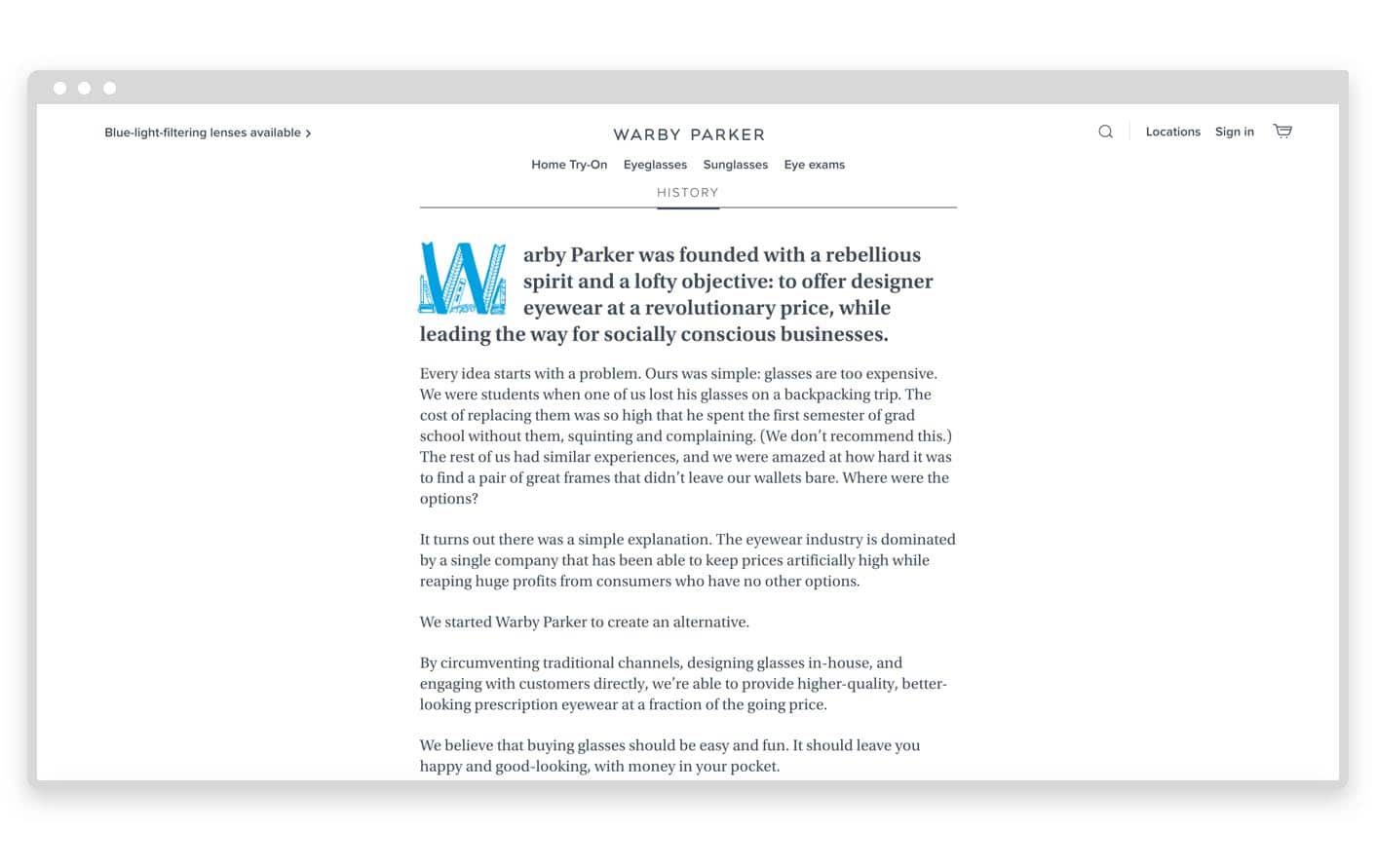
Visual Storytelling
This can be anything from an infographic to an image. Video is of course also included here but for the sake of this article, we are going to give it its own category.
Example: TouchCommerce does a great job of using visual content to tell a story. With the help of this infographic, they teach their audience what goes on in the mind of a mobile consumer and ultimately, why they need an omni-channel solution.
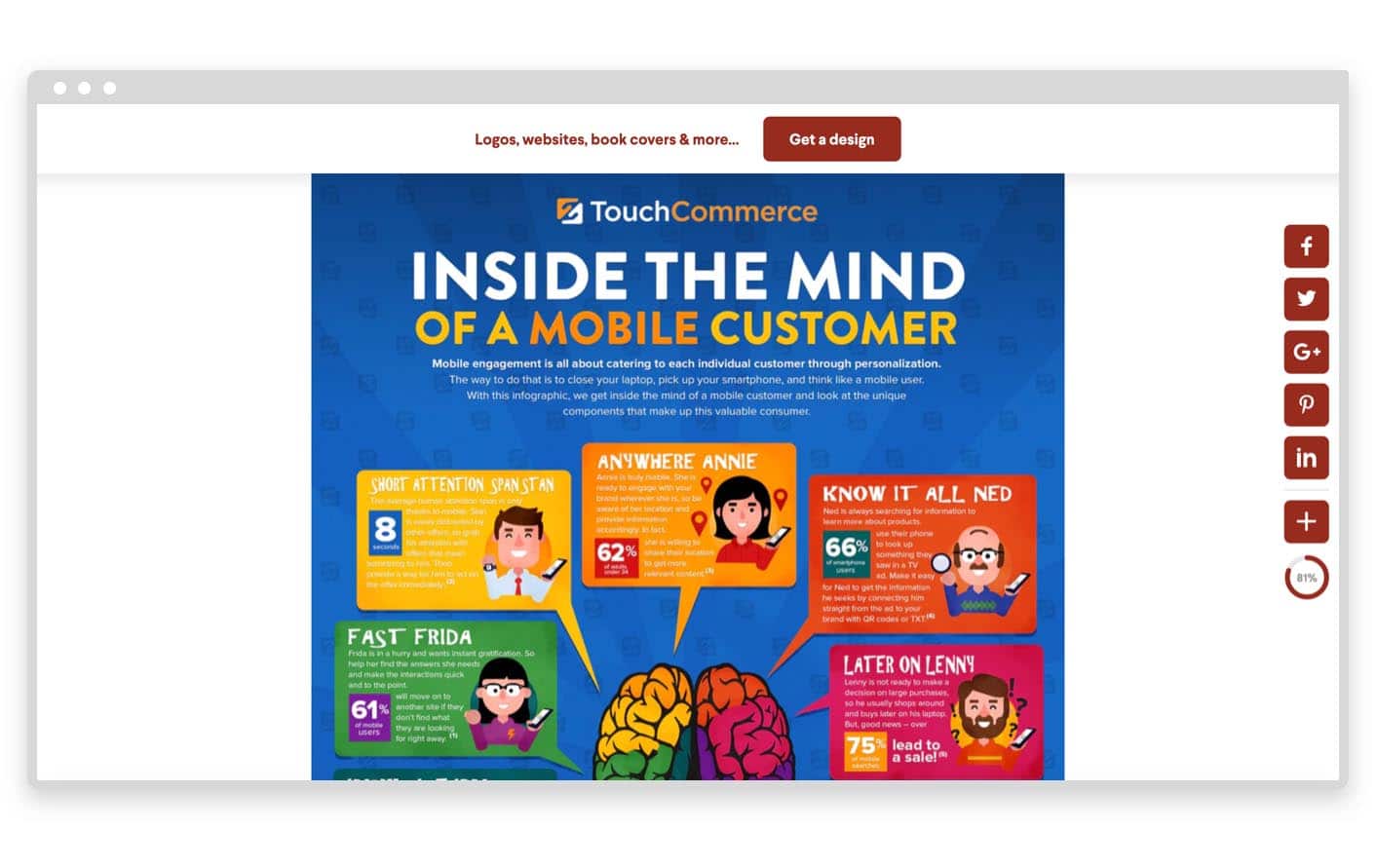
Video Storytelling
It’s no secret that video content is a powerful way to tell your marketing story. The medium itself is one of the most effective marketing tools and we’re seeing its presence grow on all advertising platforms. Video marketing can be expensive and time-consuming but it’s all worth it when you are able to grab your customer’s attention and foster an emotional connection.
Example: What story is more relatable than a long commute home? In this video, Apple portrays an everyman hero that accurately depicts so many of us. The ad tells a story that we have all experienced and a solution that we all dream of.
Pro-tip: Creating videos for your business doesn’t have to be as difficult and expensive as you think. With Promo.com’s easy-to-use video maker, you can make video ads all by yourself in a matter of minutes.
Social Media Storytelling
A social media story can be made up of multiple building blocks. It can include videos, captions, GIFs, and images. But more importantly, a story told on social media has the added quality of viewer involvement.
It is no longer a one-way relationship between a storyteller and an audience. Social media allows brands to invite their audience to contribute to the stories told, making it a living organism that invites your audience to take an active part.
Example: Take, for instance, Dove’s ad campaign to promote their DermaSeries. The hero of their story are the people they feature, but also the audience that they’re targeting. Anyone who can relate to the hero’s complication can take part in the story.
Pro-tip: When telling your story on social media, encourage your viewers to share their experiences in the comments so that they feel that they, too, are the hero of the story.
Transmedia storytelling
But why use one medium when you can use them all? To take it to the next level, you’ll need to explore multi-platform/cross-channel storytelling. In this digital marketing era, your story shouldn’t end at one video ad, one commercial or one blog post.
To truly foster a connection with your audience, your business should embody the story that you are selling. Your story should be told everywhere – on your website, on your social platforms, in your email marketing and anywhere else your business shows its face.
Example: Tide is weaving a story around their brand and that means that it encompasses their entire marketing strategy and not just one Super Bowl.
This punchline, which later became their rallying cry, is followed up in additional commercials and moved on to other channels, engaging their followers in on-point tweets.
Clean clothes are an indication of a Tide ad. If you experience a stain, please find some Tide. #TideAd #SB52 #SBLII pic.twitter.com/hDDt0uR1nH
— Tide (@tide) February 5, 2018
Aspire to live stain-free with Tide. #TideAd #SB52 #SBLII pic.twitter.com/irslnooLdv
— Tide (@tide) February 5, 2018
Of course, with big brands such as these, a transmedia campaign often takes on a life of its own with memes and trending #TideAd quotes, furthering brand awareness and affirming the story that they are telling.
Pro-tip: You can tell one narrative through multiple lenses on various mediums. When revealing different pieces of the story every time, your viewers feel invested, involved and always connected.
The marketing story checklist
To sum up, let’s take a look at our marketing storytelling checklist. As any decent literature professor will tell you, a good story is subjective and can’t be defined in black and white variables. However, when it comes to marketing, we can leave you with some guidelines that you should always try to incorporate into your next campaign.
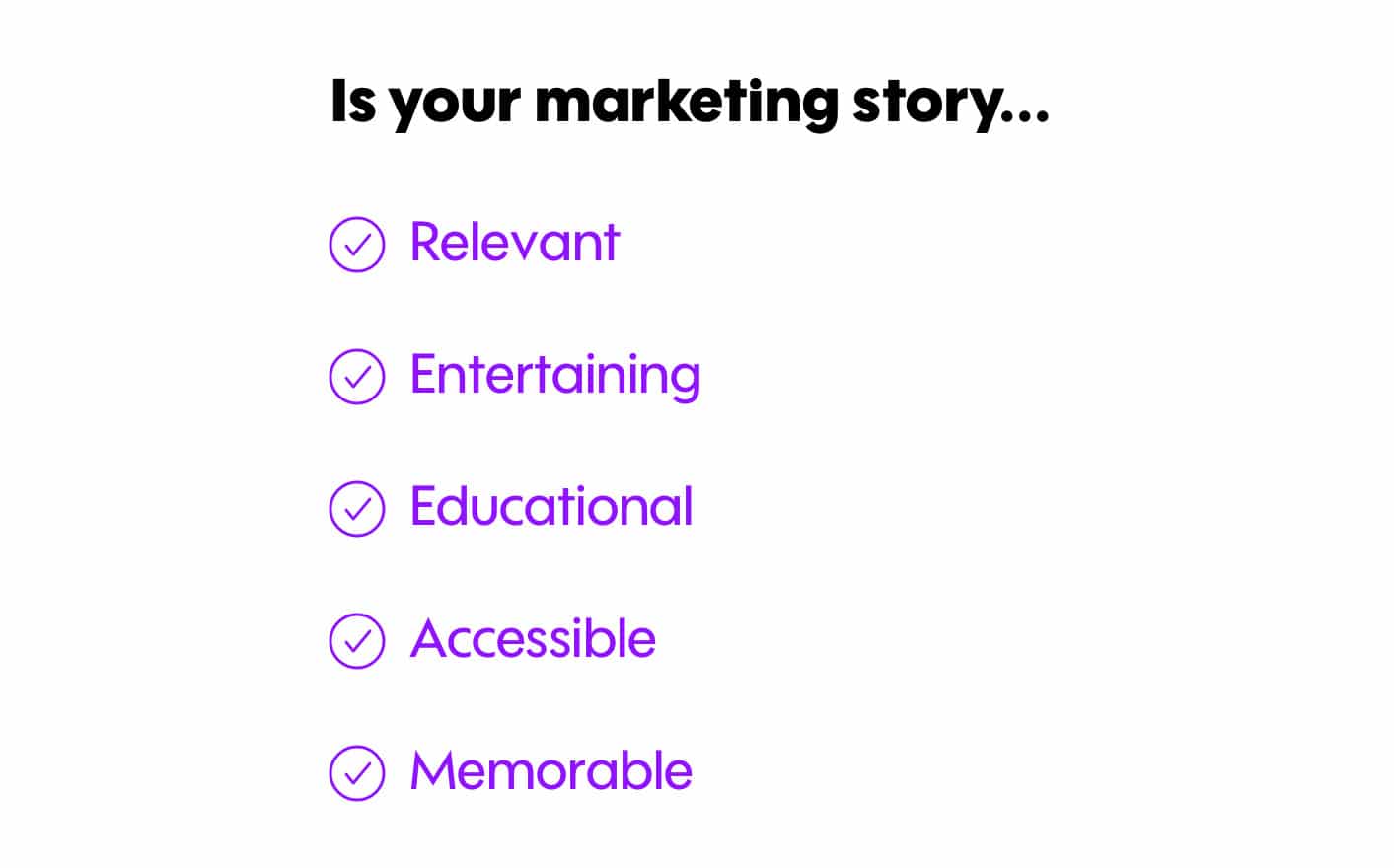
- Relevant – A great story is universal, but in this case, the most important factor is that it is relevant and relatable to your target audience.
- Entertaining – Every story should keep its audience engaged and interested in what is yet to come. This can be achieved by humor, drama or anything in between.
- Educational – Every story should have a takeaway. Whether it’s a moral lesson or a new fact, the audience should finish the story knowing something they didn’t know when they started it.
- Accessible – If a great story is told but nobody hears it, is it even a great story? Make sure your story is told on the right channels and presented to the right audience.
- Memorable – Once you get your message across, make sure it has the potential to resurface in the shopping aisle or the next time the viewer is in need of your service.
The End
When it comes to storytelling in the marketing world, this is just the tip of the iceberg. While this is more than enough to get you started, there are plenty of resources out there to help you spread your business’s stories.
To tell your story with the power of video, head on over to Promo.com and get started today!
